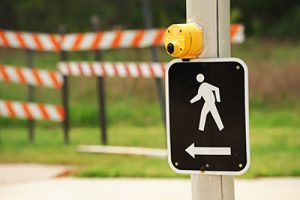
One of the best ways to stay safe as a pedestrian is to follow all pedestrian safety laws. These laws are in place to make it clear who has the right of way and who should yield every time you encounter a car. These situations leave little room for error. As a pedestrian, you don’t have the benefit of a car to protect your body, so any crash is likely to result in severe injury or death. Behaving predictably so that drivers know where and when you’ll be on the road can save your life. By the same token, drivers should also understand when pedestrians have the right of way.
In Marked Crosswalks
Pedestrians have the right of way in marked and unmarked crosswalks. As a driver, you must always come to a complete stop and let them pass safely, whether they’re crossing your lane or not. It’s also illegal for your vehicle to block a crosswalk.
At Pedestrian Crossing Signals
Pedestrian crossing signals give the walk sign to pedestrians going the same direction as traffic. Drivers turning at these intersections should always yield regardless of whether they’re turning right or left. Note: if the crossing signal has switched to indicate that pedestrians should wait, pedestrians already in the crosswalk still have the right of way. They may finish crossing. If they arrive at the crosswalk while the wait signal is blinking, however, they should not step into the road until they get a new walk signal.
When a Driver Turns on Red
When a driver is turning at a red light, pedestrians in the adjacent crosswalk have the right of way. So, you may still turn, but you must first yield to anyone in the crosswalk. Again, the pedestrian has the right of way when they are traveling in the direction of traffic.
When Do Drivers Have the Right of Way?
There are also situations where pedestrians should yield to drivers. Stepping into the road when drivers have the right of way, even if you don’t see a car at that moment, is extremely dangerous.
When There is No Crosswalk
It’s always safest to cross at marked crosswalks and at intersections with pedestrian signals. Still, sometimes people still need to cross when there are none nearby. In these cases, often called mid-block crossings, pedestrians must yield to all vehicles.
If the Pedestrian Crossing Signal is Red
If the pedestrian signal says, “don’t walk,” or has a red hand, vehicle traffic coming in the other direction has the green light and therefore has the right of way.
Pedestrian Safety is a Two-Way Street
Drivers and pedestrians need to share the road, follow all pedestrian safety laws, and yield as appropriate. Whether or not you expressly have the right of way, you should make all reasonable efforts to avoid a collision. There’s no such thing as a minor pedestrian crash. More than 100 Maryland pedestrians die in crashes each year, all of which are preventable tragedies. Look Up, Look Out, and Look Alive!